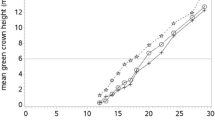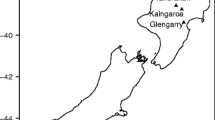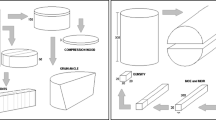Abstract
• Context
The frequency, size, and insertion angle of primary branches are important determinants of wood quality and can be significantly influenced by silvicultural activities.
• Aims
This study quantified the long-term influence of early re-spacing on the branching characteristics of mature Sitka spruce [Picea sitchensis (Bong.) Carr.] trees growing in Northern Ireland, UK. The primary aim was to investigate whether any residual effect of stand density on branch attributes remained once the effect of changes in tree size variables had been considered, while a secondary objective was to test the performance of existing Sitka spruce branch models using the current dataset.
• Methods
Re-spacing treatments had corresponding stand densities of 2,858, 1,452, 725, 477, and 320 stems ha−1. Twenty-four trees were sampled when the stand was 57 years old and branch frequency, size, and insertion angle were recorded for model development.
• Results
Maximum branch diameter, insertion angle, and branch frequency were significantly influenced by re-spacing, while no effect was found for relative branch diameter distribution. Residual re-spacing effects were most noticeable on branch size, with only small differences between treatments for branch frequency and insertion angle. Existing models performed well despite the wider range of stand densities examined in the present study.
• Conclusion
The results indicate that early re-spacing from 1.9 m2 to wider than 2.6 m2 will result in branch attributes that are detrimental to Sitka spruce sawn timber quality.




Similar content being viewed by others
References
Achim A, Gardiner BA, Leban J-M, Daquitane R (2006) Predicting the branching properties of Sitka spruce grown in Great Britain. NZ J For Sci 36:246–264
Akaike H (1974) A new look at the statistical model identification. IEEE Trans Autom Control 19:716–723
Barthélémy D, Caraglio Y (2007) Plant architecture: a dynamic, multilevel and comprehensive approach to plant form, structure and ontogeny. Ann Bot-London 99:375–407
Brazier JD (1970) Timber improvement II: the effect of vigour on young growth Sitka spruce. Forestry 43:135–150
Brazier JD (1977) The effect of forest practices on quality of the harvested crop. Forestry 50:49–66
Burnham KP, Anderson DR (2002) Model selection and multimodel inference: a practical information-theoretic approach. Springer, New York
Cannell MGR (1974) Production of branches and foliage by young trees of Pinus contorta and Picea sitchensis: provenance differences and their simulation. J Appl Ecol 11:1091–1115
CEN (2003) Structural timber—strength classes. EN338:2003, European Committee for Standardization, Brussels, Belgium
Colin F, Houllier F (1991) Branchiness of Norway spruce in north-eastern France: modeling vertical trends in maximum nodal branch size. Ann For Sci 48:679–693
Colin F, Houllier F (1992) Branchiness of Norway spruce in northeastern France: predicting the main crown characteristics from usual tree measurements. Ann Sci Forest 49:511–538
Forestry Commission (2010) Forestry facts and figures 2010: a summary of statistics about woodland and forestry. Forestry Commission, Edinburgh
Deal RL, Barbour RJ, McClellan MH, Parry DL (2003) Development of epicormic sprouts in Sitka spruce following thinning and pruning in south-east Alaska. Forestry 76:401–412
Fonweban JB, Gardiner BA, Macdonald SE, Auty D (2011) Taper functions for Scots pine (Pinus sylvestris L.) and Sitka spruce (Picea sitchensis (Bong.) Carr.) in northern Britain. Forestry 84:49–60
Forest Products Laboratory (2010) Wood handbook, wood as an engineering material. General technical report FPL-GTR-190. U.S. Department of Agriculture, Forest Service, Forest Products Laboratory, Madison, 508 p
Garber SM, Maguire DA (2003) Modeling stem taper of three central Oregon species using nonlinear mixed-effects models and autoregressive error structures. Forest Ecol Manag 179:507–522
Garber SM, Maguire DA (2005) Vertical trends in maximum branch diameter in two mixed-species spacing trials in the central Oregon Cascades. Can J Forest Res 35:295–307
Gardiner BA, Leban J-M, Auty D, Simpson H (2011) Models for predicting wood density of British-grown Sitka spruce. Forestry 84:119–132
Grace JC, Pont D, Goulding CJ (1999) Modelling branch development for forest management. NZ J For Sci 29:391–408
Guilley E, Hervé JC, Nepveu G (2004) The influence of site quality, silviculture and region on wood density mixed model in Quercus petraea Liebl. Forest Ecol Manag 189:111–121
Halsall L, Gilbert J, Matthews, R, Fairgrieve, M (2006) United Kingdom: new forecast of softwood availability. Forestry Commission Edinburgh
Hein S, Weiskittel AR, Kohnle U (2008a) Branch characteristics of widely-spaced Douglas-fir in south-western Germany: comparisons of modelling approaches and geographic regions. Forest Ecol Manag 256:1064–1079
Hein S, Weiskittel AR, Kohnle U (2008b) Effect of wide spacing on tree growth, branch and sapwood properties of young Douglas-fir [Pseudotsuga menziesii (Mirb.) Franco] in southwestern Germany. Eur J Forest Res 127:481–493
Heuret P, Meredieu C, Coudurier T, Courdier F, Barthélémy D (2006) Ontogenetic trends in the morphological features of main stem annual shoots of Pinus pinaster (Pinaceae). Am J Bot 93:1577–1587
Houllier F, Leban J-M, Colin F (1995) Linking growth modelling to timber quality assessment for Norway spruce. Forest Ecol Manag 74:91–102
Jack WH (1971) The influence of tree spacing on Sitka spruce growth. Irish Forestry 28:13–33
Joyce PM, OCarroll N (2002) Sitka spruce in Ireland. National Council for Forest Research and Development (COFORD), Dublin
Kampstra P (2008) Beanplot: a boxplot alternative for visual comparison of distributions. J Stat Software 28:1–9
Kilpatrick DJ, Sanderson JM, Savill JS (1981) The influence of five early respacing treatments on the growth of Sitka spruce. Forestry 54:17–29
Littel RC, Milliken GA, Stroup WW, Wolfinger RD (2002) SAS system for mixed models. SAS Institute Inc., Cary
Macdonald SE, Hubert J (2002) A review of the effects of silviculture on timber quality of Sitka spruce. Forestry 75:107–138
Macdonald SE, Gardiner BA, Mason WL (2010) The effects of transformation of even-aged stands to continuous cover forestry on conifer log quality and wood properties in the UK. Forestry 83:1–16
Maguire DA, Kershaw JA, Hann DW (1991) Predicting the effects of silvicultural regime on branch size and crown wood core in Douglas-fir. Forest Sci 37:1409–1428
Mäkinen H, Colin F (1999a) Predicting the number, death, and self-pruning of branches in Scots pine. Can J Forest Res 29:1225–1236
Mäkinen H, Colin F (1999b) Predicting branch angle and branch diameter of Scots pine from usual tree measurements and stand structural information. Can J Forest Res 28:1686–1696
Mäkinen H, Hein S (2006) Effect of wide spacing on increment and branch properties of young Norway spruce. Eur J Forest Res 125:239–248
Maun KW (1992) Sitka spruce for construction timber: The relationship between wood growth characteristics and machine grade yields of Sitka spruce. Research information note 212. Forestry Commission: Edinburgh, UK.
McCullagh P, Nelder JA (1989) Generalized linear models. Chapman & Hall, London
Moore JR, Achim A, Lyon A, Mochan S, Gardiner BA (2009) Effects of early re-spacing on the physical and mechanical properties of Sitka spruce structural timber. Forest Ecol Manag 258:1174–1180
Parresol BR (1999) Assessing tree and stand biomass: a review with examples and critical comparisons. Forest Sci 45:573–593
Pinheiro JC, Bates DM (2009) Mixed-effects models in S and S-PLUS. Springer, New York
Quine CP (2004) Development of epicormic sprouts on Sitka spruce stems in response to windthrown gap formation. Forestry 77:225–233
R Development Core Team (2011) R: a language and environment for statistical computing. R Foundation for Statistical Computing, Vienna
Schneider R, Zhang SY, Swift DE, Bégin J, Lussier J-M (2008) Predicting selected wood properties of jack pine following commercial thinning. Can J Forest Res 38:2030–2043
Tasissa G, Burkhart HE (1998) An application of mixed effects analysis to modeling thinning effects on stem profile of loblolly pine. Forest Ecol Manag 103:87–101
Wardle PA (1967) Spacing in plantations: a management review. Forestry 40:47–69
Weiskittel AR, Maguire DA, Monserud RA (2007) Modeling crown structural responses to competing vegetation control, thinning, fertilization, and Swiss needle cast in coastal Douglas-fir of the Pacific Northwest, USA. Forest Ecol Manag 245:96–109
Weiskittel AR, Seymour RS, Hofmeyer PV, Kershaw JA (2010) Modelling primary branch frequency and size for five conifer species in Maine, USA. Forest Ecol Manag 259:1912–1921
Worrell R (1987) Geographical variation in Sitka spruce productivity and its dependence on environmental factors. PhD dissertation. University of Edinburgh, Edinburgh, UK
Zhang S, Chauret G, Ren HQ, Desjardins R (2002) Impact of initial spacing on plantation black spruce lumber grade yield, bending properties, and MSR yield. Wood Fiber Sci 34:460–475
Acknowledgements
We would like to thank Baronscourt Estate and the Northern Ireland Forest Service for allowing access to the trial. Shaun Mochan helped to manage the field project and Elspeth Macdonald, Paul McLean, David Swinson, Floran Pierre, and staff from the Agricultural Food and Bioscience Institute assisted with the field sampling. Drs. Thomas Connolly and Helen McKay provided helpful comments on an earlier version of the manuscript, and we also thank the anonymous reviewers for their valuable comments. The work was funded by the Forestry Commission Corporate and Forestry Services and by a Strategic Research and Development Grant from the Scottish Funding Council.
Author information
Authors and Affiliations
Corresponding author
Additional information
Handling Editor: Jean-Michel Leban
Rights and permissions
About this article
Cite this article
Auty, D., Weiskittel, A.R., Achim, A. et al. Influence of early re-spacing on Sitka spruce branch structure. Annals of Forest Science 69, 93–104 (2012). https://doi.org/10.1007/s13595-011-0141-8
Received:
Accepted:
Published:
Issue Date:
DOI: https://doi.org/10.1007/s13595-011-0141-8




